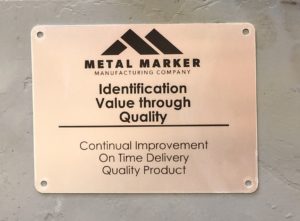Nearly every company involved in the industrial sector utilizes some form of metal identification. Organizations rely on barcode asset nameplates, data nameplates with equipment information, or even warning signs and labels.
If you’re going to use metal nameplates, they need to be attached to a surface or object. This could be directly on a piece of machinery, on a shop wall, or around pipes and valves.
No matter how you need to affix your nameplates, there is a nameplate attachment option for you.
Holes
One of the most common solutions for mounting metal nameplates and nameplates is by utilizing holes. These are cut directly into the nameplate during production, allowing for easy installation by the end user.
Any number of holes can be added to nearly any nameplate. Whether it’s just one or two, four corners, or some unique pattern.
To install the plate, screws and/or bolts are used to directly mount on a surface. Using metal hardware is a very durable method, allowing the nameplates to remain sturdy in tough conditions.
Wires/Chains
What happens when I need to attach a nameplate to a non-flat surface?
Wires can be used to attach nameplates to a wide range of surfaces. Everything from pipes to valves to fire hydrants can utilize metal identification without making any modifications.
All it takes is using a wire or chain. These loop through holes on the metal nameplates and wrap around the desired location.
Welding
If you are looking for a permanent attachment solution for a metal nameplate, welding is a reasonable option.
Directly welding the metal nameplate to the desired surface eliminates the risk of screws coming loose or adhesive wearing out. For example, metal name plates on boilers typically feature welded plates.
Keep in mind that metal identification products are manufactured with a large variety of materials. Some materials may be better to weld. It depends on the environment, material, and process.
Adhesive Backing
Looking for the quickest and easiest solution? Add adhesive backing to your nameplates or nameplates. This adds a thin paper which peels off to expose an industrial grade name plate adhesive.
These adhesives feature varying levels of strength, from everyday applications to some of the toughest industrial conditions. This includes resistance to weather and other adverse elements.

The best part of choosing to use adhesives is the ease of use. You simply peel of the backing, place the nameplate on a clean & dry surface, and let it sit for 24-48 hours. That’s it. It’s really that easy.
Adhesive backing eliminates messing with additional hardware or welding. In addition, anyone can apply the nameplates. Whether it’s a skilled worker or a helping hand around the shop.
The ease of use also makes applying large quantities of nameplates in a quick time frame much more feasible. In comparison, hand welding 1000 nameplates can be a daunting task.
Cable Ties
What about attaching my nameplate to a pipe or cable? While there is always the option for using a wire or chain, some situations are best suited for a metal cable tie.
These elongated metal nameplates wrap around a cylinder and fold over themselves, creating a lasting hold. This is perfect for wrapping around wires, pipes, well pipes, cables, hydraulic hoses, and more.
In addition, cable ties do not need any additional hardware or processes. They are a self-contained mounting solution.
Limitations for Each Process
Just like every work environment is unique, every metal identification solution is unique. There is no one-size-fits-all fix. Fortunately, there an array of marking processes used to fit different applications.
Embossing
Embossing is a highly durable process, with high visibility. This makes it an appealing solution for many industrial applications.
These nameplates can be affixed to a location using holes, either via a wire or hardware.
One limitation to the embossing process is that it cannot utilize an adhesive backing. Since the nameplate will be pressed on both sides, the backside will be indented upwards. This means an adhesive on the back would not have the surface area to provide a quality hold.
MetalPhoto
Photo anodization (MetalPhoto) is one of the most versatile processes to select from. It uses a specialized process to create a design protected by layers of aluminum.
Unlike some other processes, MetalPhoto is ideal for adhesive backing. The flat back side of the nameplate provides a perfect surface for the adhesive to create a strong hold on equipment, machinery, and more.
If adhesive doesn’t work for your application or you simply prefer holes, photo anodization is equally capable of fitting that need. Holes of any shape or size can be cut into any location of the nameplates, making them able to adjust to any situation.
Wrap-Up
Nameplate attachment is an important consideration when ordering nameplates. You don’t want to be standing on the job site with a box full of nameplates and bolts to mount them with and realize you forgot to specify you needed holes.
The good news is there are nameplate mounting solutions for any application. All you have to do is decide which is best for your organization.